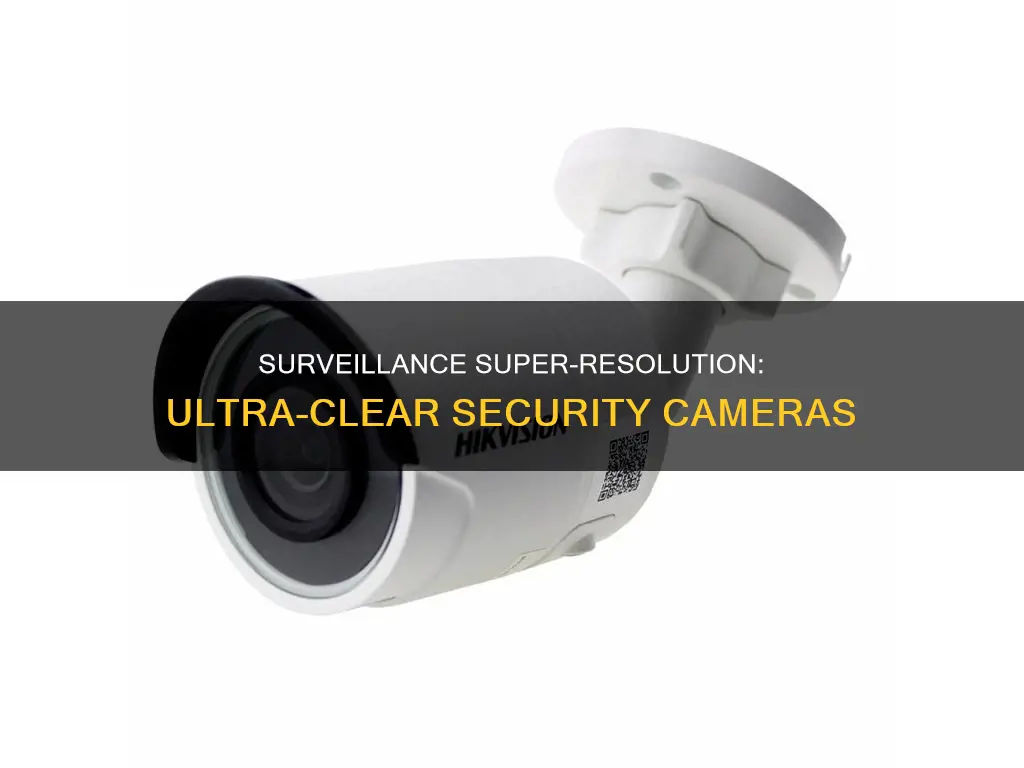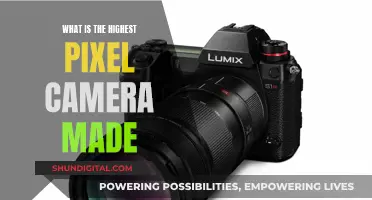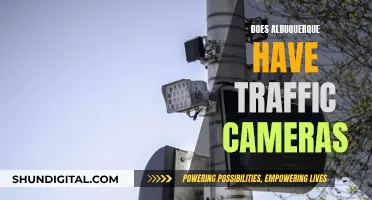
The highest resolution surveillance cameras on the market today offer 4K clarity, with some manufacturers pushing beyond this standard. For example, Reolink has launched 12MP and 16MP camera models, with their latest 16MP model being the Duo 3 PoE. However, the resolution of a camera is not the only factor that determines the clarity of the image it produces. The lens of the camera is also important, with higher-quality lenses allowing for better image quality. Other features to consider when purchasing a high-resolution surveillance camera include power source options, internet connectivity, audio capabilities, and cost.
| Characteristics | Values |
|---|---|
| Highest Resolution | 8K |
| Practical Resolution | 4K |
| Resolution for Detailed Monitoring | 4K |
| Resolution for General Surveillance | 720p, 1080p |
| Resolution for Outdoor Surveillance | 4K |
| Resolution for Indoor Surveillance | 1080p |
What You'll Learn

4K resolution: the highest resolution for security cameras
When it comes to security cameras, having a clear and detailed image can be the difference between recognising a face and missing a crucial piece of evidence. While the standard for surveillance cameras used to be grainy, blurry footage, 4K resolution has revolutionised the industry, offering superior clarity and detail.
4K resolution, also known as Ultra High Definition (UHD), is a standard that provides 3840 x 2160 pixels, creating a high-quality, detailed image. With 4K, you get a level of detail that can make a significant difference in surveillance footage, allowing for the identification of specific individuals, licence plates, or the monitoring of goods handling.
Benefits of 4K Resolution for Security Cameras
The higher resolution of 4K means a wider field of view, which is ideal for monitoring large areas like parking lots or open spaces. The increased number of pixels also improves image clarity, especially over distance and in varying lighting conditions, ensuring that no critical details are missed.
Drawbacks of 4K Resolution
One of the main drawbacks of 4K resolution is the storage requirements. 4K cameras produce large data files, and as such, require more storage space. This can be a significant consideration for businesses or individuals with extensive surveillance needs, as it may result in higher costs for additional storage hardware.
Additionally, 4K resolution may be overkill for certain situations, such as indoor surveillance in well-lit areas, where lower resolutions like 1080p can provide sufficient image quality without the same storage demands.
When to Choose 4K Resolution
4K resolution is ideal for situations where detailed monitoring is required, such as in applications that need to read licence plates or recognise faces. It is also recommended for outdoor surveillance, where the camera needs to compensate for lighting and distance challenges.
Alternative Resolutions
For general overview monitoring or indoor surveillance, lower resolutions like 720p or 1080p can provide a balance between image clarity and storage requirements. While these resolutions may not offer the same level of detail as 4K, they are often sufficient for general security purposes and can help to conserve storage space.
Charging the Fuji XT-30: A Quick Guide
You may want to see also

12MP: the highest resolution supported by mainstream IP cameras
12MP is currently the highest resolution supported by mainstream IP cameras. This resolution is also known as 4K (IP) and offers an extremely high level of detail, allowing for the recognition of faces and license plates, even when zoomed in. However, it is important to note that this level of resolution comes with drawbacks, including high costs and extremely large file sizes. In addition, such high resolutions may not be necessary for security purposes, as lower-resolution cameras can also provide sufficient detail for surveillance.
The resolution of a camera refers to the number of pixels that make up an image. Higher resolutions mean more pixels, resulting in clearer and more detailed images. While 12MP offers the highest resolution currently available in mainstream IP cameras, there are other options available that provide adequate image quality for surveillance purposes. For example, 4K resolution, which is slightly lower than 12MP, provides superior clarity and detail for more detailed monitoring. This resolution is ideal for situations where specific individuals need to be identified, license plates need to be read, or the handling of goods needs to be monitored closely.
For general surveillance, lower-resolution cameras can be effective. Resolutions such as 720p or 1080p offer a balance between providing clear images and identifying larger incidents, without requiring excessive storage space. These lower-resolution cameras are often sufficient for indoor surveillance, especially in well-lit areas with a less expansive field of view.
It is worth noting that the resolution of a camera is just one factor to consider when choosing a surveillance system. Other factors, such as frame rate, camera placement, lighting, and maintenance, also play a crucial role in the overall effectiveness of the system. Additionally, the specific needs and budget of the user should be taken into account when deciding on the resolution and other specifications of the cameras.
In summary, while 12MP is the highest resolution currently supported by mainstream IP cameras, it may not be necessary for everyone. Lower-resolution cameras can also provide sufficient image quality for surveillance, and it is important to consider the specific needs and requirements of the user when making a decision.
Reactivate Foscam Surveillance Cameras: A Step-by-Step Guide
You may want to see also

1080p: the most used and supported HD standard
1080p is the most used and supported HD standard for security cameras. It is the ideal resolution for security cameras, providing clear and sharp images that capture the detail needed for surveillance. This resolution is also known as 2MP, with a width of 1920 pixels and a height of 1080 pixels, giving a total of 2,073,600 pixels in each image. This resolution is perfect for most businesses, providing solid camera resolution to satisfy advanced surveillance, even if a lot of action occurs in the area.
The 1080p resolution is equivalent to Blu-ray quality and allows for facial recognition up to 30ft away, with an 80-degree viewing angle. The HD video captured by these cameras can be magnified to look at objects of interest, and the footage is 225% larger in size compared to analog D1 or 960H resolution. 1080p security cameras are also a great choice for customers looking to upgrade their existing CCTV system to high definition, as they can use the same RG59 coax cable as traditional CCTV cameras.
The 1080p resolution is suitable for both indoor and outdoor security cameras. For outdoor cameras, a resolution upwards of 720p is recommended to display greater detail, as there are more significant lighting and environmental changes. 1080p is a great image quality for outdoor surveillance, providing clear and sharp images that are detailed enough to capture the necessary information.
For indoor security cameras, a lower resolution can be used, as they tend to be closer to the Wi-Fi router, providing a stronger connection. However, 1080p is still a good choice for indoor cameras, as it is the most used and supported HD standard, providing great image quality for indoor surveillance.
The Evolution of Cameras: Is the Classic Camer Still Kicking?
You may want to see also

720p: the lower threshold of HD
720p is the lower threshold of HD, providing crisp and sharp images. However, it may not offer sufficient detail for monitoring distant objects or subjects. It is a good option for indoor security cameras as it strikes a balance between image quality and performance, without overburdening wireless routers. 720p cameras are also relatively inexpensive.
When compared to 1080p, 720p has a lower resolution and requires less storage space. A one-hour 1080p recording uses 675 megabytes (MB) of space, while a 720p recording of the same duration consumes only 288 MB. This difference in storage requirements becomes significant when continuous recording over extended periods is necessary, such as during vacations.
The choice between 720p and 1080p depends on the specific needs of the user. 720p is adequate for many users and is suitable for smaller, well-lit spaces with a clear field of view. However, for larger spaces or situations where long-distance identification is required, an upgrade to 1080p may be beneficial. The higher resolution of 1080p provides greater detail and is more effective for monitoring larger areas, such as residential yards, walkways, driveways, and commercial properties.
It is worth noting that the resolution of a security camera is just one factor to consider when choosing a surveillance system. Other aspects such as budget, audio quality, zoom capability, lighting conditions, and network stability also play a crucial role in determining the effectiveness of a security camera setup.
Fight Traffic Camera Tickets: Florida Drivers' Guide
You may want to see also

24MP: the highest-resolution time-lapse camera
The 24MP camera is the highest-resolution time-lapse camera offered by ECAMSECURE, providing the best in high-definition visualization. With a resolution of 24 megapixels, or 24 million pixels, this camera captures highly detailed and clear images that are ideal for various applications, including surveillance, professional photography, and medical imaging.
One of the key advantages of the 24MP camera is its ability to zoom in on precise details without losing resolution. This feature is particularly useful for forensic analysis and close-up inspections. The camera also offers financial flexibility, as it can be purchased as a capital expense or leased as an operational expense.
The 24MP camera is designed for precision and allows users to digitally zoom in on captured images, making it perfect for creating client presentations and probing areas of interest. The camera can capture time-lapse sequences at intervals of your choice, providing the flexibility to document projects over extended periods.
In addition to its high resolution, the 24MP camera stands out for its remote accessibility. Users can access the camera feed from anywhere using any internet-connected device, making it convenient for remote monitoring and site management.
When choosing a camera for long-term time-lapse projects, it is essential to consider factors beyond just resolution. Reliability, durability, and data storage capabilities are also crucial aspects to ensure the camera can withstand the demands of extended use.
In conclusion, the 24MP camera from ECAMSECURE offers exceptional image quality and is well-suited for applications requiring detailed and clear visuals. Its high resolution, digital zoom capabilities, and remote accessibility make it a powerful tool for surveillance, construction site monitoring, and any scenario requiring meticulous observation.
Fight Portland Camera Tickets: Your Comprehensive Guide
You may want to see also
Frequently asked questions
The highest resolution surveillance camera currently available is the Reolink Duo 3 PoE, which has a resolution of 16MP.
For capturing license plates, a camera with a high optical zoom is required. The Verkada CD42 Indoor Dome Camera is a suitable option, as it offers a resolution of 5MP and can be strategically placed to capture license plates.
The Reolink E1 Outdoor Pro is an excellent choice for outdoor surveillance. It offers a resolution of 4K UHD and features such as pan-tilt-zoom (PTZ) and WiFi 6 connectivity.
The TP-Link Tapo Pan/Tilt C210 Camera is a great budget option, offering features such as pan and tilt capabilities, motion and audio detection, and local or cloud storage, all for under $30.







